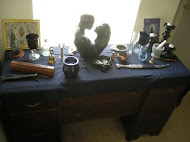Male Fern
The Male Fern is also called by the names Male Shield Fern - Dryopteris Filix-mas; Bracken Fern - Pteris Aquilina; and Moonwort - Botrychium lunaria. The male fern is also known as the ‘bear’s paw’ and it probably earned this nickname owing to the look of its rhizomes or tubers that are hairy and dark brown. Scientifically, the male fern is called Dryopteris meaning ‘oak fern’ in Greek. It acquired this name because the male fern is habitually found to grow in oak woods. On the other hand, botanists call this species ‘filix-mas’ meaning the ‘male fern’. Interestingly, another species called the Athyriumfilix-femina or the ‘lady fern’ has been named so owing to its fragile appearance. Significantly, till the middle of 1800 botanists were in the dark regarding the fact that the ferns do not have any gender and there is nothing like "male" or "lady" fern in reality. In fact, the spores found in the underneath of the fern leaves or fronds produce both male as well as female cells. These spores are not visible to the naked eyes and the strange renewal of ferns, at times, has given rise to an antique faith that the spores found in the underneath of the fern leaves or fronds bestows invisibility to people on whom it is showered. Even Shakespeare refers to this belief indirectly in his play Henry IV, where he writes “We have the receipt of fern seed, we walk invisible.”
Planet: Mercury
Element: Air
Part Used: Leaves and stems
This fern appears to have some qualities in common with the Bracken. The ashes of both have been used in soap and glassmaking, and the young curled fronds have been boiled and eaten like Asparagus. The inhabitants of Palmaand Gomera (islands of the Canary Group) use it as food, grinding the rhizome to powder and mixing it with a small quantity of barley, and the young fronds are eaten in Japan. In Siberia and in Norway, the uncoiled fronds have been used for brewing a kind of beer. In times of great scarcity the Norwegians (over a century ago) used the fronds to mix with bread and also made them into beer. The leaves, cut green and dried, make an excellent bitter, and when infused in hot water make good fodder for sheep and goats.
The male fern is one of the most powerful medications for tapeworm ever documented in the records of medicine - the root can be used in a powdered form. Right from the days of the ancient Greek civilization to the present day, male fern has been recommended by most physicians to expel worms from the body. The root powder can also be added to salve for wounds and burns, and over the centuries people have been making use of oil taken out from the tuber or rhizome of the herb to cure problems arising from liver flukes or barbs. Despite its medical utility, the U.S. Pharmacopeia listed the male fern for medical use quite late - 1965. It is interesting to note that even Louis XVI of France coughed up a hefty sum to obtain a remedy containing the male fern.
*****Here is a word of caution. It must always be borne in mind that excessive dosage of the male fern is highly noxious and one should never use the herb without consulting qualified physicians. If taken in high doses, medicines prepared from the male fern may prove to be fatal too.
Father Kunzle's Oil
- 5 fern fronds, well dried
- 4/5 (200 ml) cup olive oil
Detach the dried leaflets from the stems and macerate in the oil for 1 month. Carefully strain. This oil can be kept for 6 months away from light. This is an ideal massage oil for muscular pain.
Normally this useful herb grows up to two to four feet in height and bears insipid green leaves also known as fronds. These fronds are narrow and tasseled and grow closely packed all the way up to the fleshy stem. On the underside of the fronds, there are two rows of dark brown spores. The rhizome or tuber of the male fern is reddish brown in color and is usually small, bulky and scaled. As mentioned earlier, the spores found underneath the fern leaves or fronds produce both male and female cells. Thus, the ferns reproduce from these spores.
In many cultures across the globe, people think that the ferns have the capability to transform poor people rich. For instance, a Russian myth says that if a person finds a fern blossoming on Midsummer Eve and throws the fern in the air, he will find a fortune where the fern lands. On the other hand, a fable in Syria says that collecting fern spores on Christmas night will compel the devil to part with his money.
Moonwort/Fern is an herb of immortality and must be gathered by moonlight if it is to work. Fern should be kept in a room where studying is done to help concentration, and you should burn a sprig of fern before an exam. It can also be used in sachets and amulets for powerful auric protection. You can mix fern leaves with black snake root chips and carry them in a mojo bag for protection from harm and to ward off unnatural illness.
The Fern is an extremely powerful protective plant. Grow them in and around the house for protection from evil and negativity. It aids in gaining mental clarity, and is also used for cleansing, purification, and dispelling negativity. Fern has a reputation for preventing evil from entering the home. Some folks sprinkle crushed fern leaves along the inside window sills in every room of the house to keep out burglars and other intruders. You can also brew fern leaves and black snake root together and add it to your regular floor wash to get rid of jinxes and enemy tricks laid on your doorstep. Freshly crushed fern leaves can also be used as a floor sweep by sprinkling them onto the floor and then sweeping them out the front door.
Fern can be used to bring luck and prosperity. If it is carried, it will attract women to the carrier and if it is burned outdoors it will attract rain. If the Fern is dried over a balefire on the day of the Summer Solstice, it can then be used as a protective amulet. The 'seeds' from a Fern are said to render one invisible - but only if the seeds are gathered on Mid-Summer's Eve. It is claimed to aid in opening locks and was also said to have been used by the Alchemists, who thought it had power to condensate or to convert quicksilver into pure silver.
herbs2000
Disclaimer: No one involved in this blog or its contents may be held responsible for any adverse reactions arising from following any of the instructions/recipes on this list. It is the reader’s personal responsibility to exercise all precautions and use his or her own discretion if following any instructions or advice from this blog.
Fair Use Notice: This page may contain copyrighted material the use of which has not been specifically authorized by the copyright owner. This website distributes this material without profit to those who have expressed a prior interest in receiving the included information for research and educational purposes. We believe this constitutes a fair use of any such copyrighted material as provided for in 17 U.S.C § 107.







